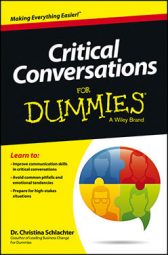Even past issues can be addressed in a critical conversation. Having a critical conversation isn’t as easy as scheduling a meeting, however. Critical conversations take work, time, and follow-up, but having a critical conversation ultimately gives you back both time and energy, after you solve the problem.
When you address people problems with respect and honesty (as you do in a critical conversation), you will gain energy, time, and most likely get people working rather than arguing, which leads to more profit, productivity, and a better work environment. Cha-ching!
Decide whether a problem still exists
When past issues need to be resolved, you have a choice: address them or hope they go away. If you’ve given the issue a few weeks (or months or years) to get resolved on its own, and it hasn’t been, you need to have a critical conversation.
Start with the most recent example of the issue first. You may need to reference past actions, but focusing on two or three key actions that are causing negative behaviors right now may be enough to start turning behavior around.
Second, focus on actions, not generalizations. Saying, “Well, no one wants to work with you because you never pull your weight on projects and are always late with your work,” is accusatory and a generalization. Instead, say, “I noticed you have not updated the presentation for our client in over 13 weeks. Your time reports are often late, causing the client invoices to be redone.”
Next, make it relevant. Nothing is worse than dragging up old issues that are no longer relevant or highly subjective. If concerns are no longer relevant, don’t hold a critical conversation of grudges — just move on.
Finally, just get it done. Addressing an issue or concern that occurred months ago — if not years ago — is never a glamorous job, but it needs to be done. The sooner you can start the conversation, the sooner the actions or behaviors can change.
Examine inherited issues
Past problems can come your way from a change in personnel — such as when you change roles and move to a new team, or when another manager sends an employee to your department so she doesn’t have to deal with the issue. However the problem comes to you, deal with it quickly to get the team off and rolling on a positive note.
If you didn’t observe past behaviors, having a critical conversation based on any fact, rather than hearsay, is difficult. If, for example, you suspect that an employee is one who’s been passed around, keep opinions and bias at bay.
Some inherited issues may come from an employee making excuses for why work was not done before (her computer crashed, she threw her phone in the bath, the dog ate her report, and then her computer crashed again when a meteor struck her house). Still others come from projects that may have never been completed. Regardless, focus on the issue directly, openly, and honestly.
For example, if an employee has been passed around, treat the employee as you would a new employee, and if her performance isn’t meeting expectations, speak up and speak up fast.
If the issue is related to an old project that left resentment in the organization, state the problem and then quickly move to focusing on the solution. For example, you may say, "I know last year’s project was not as successful as we thought it would be. I would like to recommend we learn from what went right and repeat those steps to make this year’s project perfect."
Secondhand issues often look like performance or workplace dynamic issues, but during the conversation you hear something like, “Oh, well, my old manager just let me do what I wanted,” or, “My previous manager has been letting me do this for years.” When you hear this response, keep to the facts and the consequences of the behavior. Don’t start the blame game.
Look for elephant issues: big issues nobody's talking about
Elephant issues are those things that most people in the organization are automatically thinking about, but may not talk about because of legal or cultural reasons or simple politeness. Yes, everyone knows the issue is there. And everyone is looking away.
Here are some elephants that organizations may need to address head-on before they become unresolved issues from the past:
The CEO or top performer on a team just quit this morning. Everyone is waiting to find out why.
The company just lost its biggest client. Everyone is wondering what happens next.
Yesterday afternoon, the boss and someone else got into a screaming match. No one knows why, but everyone is thinking about it.
The best way to handle the elephant in the room is to tackle it straight on using the critical conversation steps, just like any other conversation: focus on the facts, tie in the consequences of the behavior, and then discuss opinions, ideas, and perspectives.
Keep with the critical conversation model by stating the facts and helping others understand how the situation is impacting them.
For example, if you just lost your biggest customer, you may start the conversation with, “You may have heard that we have lost our biggest client. I want to talk about the facts, how it impacts you, and help everyone get to delivering the best service we can for all our customers.”
Most often, when one person starts talking about the elephant in the room, there is a big sigh of relief. Most likely everyone has been thinking of it, and the team will be relieved if the initiator takes the lead and states the facts and then helps the group understand how the situation may impact them and what they can do to make the situation better.

